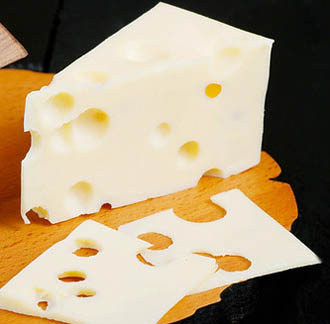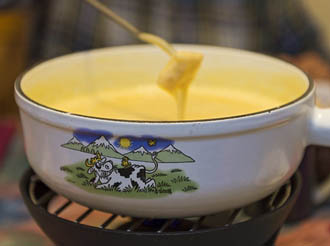Swiss cheese
Swiss cheese is a popular type of cheese that is known for its distinctive appearance, characterized by its holes or "eyes." It is a popular cheese variety enjoyed worldwide and is particularly associated with Switzerland. However, it is also produced in other countries like France and the United States.
Swiss cheese is typically made from cow's milk, although there are variations made from goat's or sheep's milk.
 |
| Swiss cheese. Courtesy: Marco Verch |
Characteristics of Swiss cheese
Swiss cheese is characterized by its large, round holes or eyes that are scattered throughout the cheese. The eyes are formed during the cheese-making process when carbon dioxide gas produced by bacteria gets trapped and create bubbles. However, the size and distribution of holes can vary depending on aging process.
Swiss cheese has a mild, nutty, and slightly sweet flavor. It has a semi-hard to hard texture, depending on the age of the cheese. Young Swiss cheese tends to be softer and more pliable, while aged Swiss cheese becomes firmer and crumbly.
Varieties: Besides the traditional Swiss cheese, there are several variations and similar cheeses. Examples include Gruyère (a firm, slightly salty Swiss cheese), Jarlsberg (a Norwegian version of Swiss cheese), and Tilsit (a semi-hard cheese with smaller holes). Each variation has its own distinct characteristics.
Production of Swiss cheese:
- Swiss cheese is typically made from pasteurized cow's milk, although there are variations made from goat's or sheep's milk.
- Milk is heated and starter cultures and rennet are added to the pasteurized milk causing them to form a solid mass called curds.
- Once the curds have formed, they are cut into small pieces to release more whey (liquid portion). The curds are then heated or "cooked" to a specific temperature, which helps expel additional whey and contributes to the texture and flavor development of the cheese.
- The whey is drained off, leaving behind the curds. The curds are typically transferred to large molds lined with cheesecloth to further drain off excess whey and pressed for several hours to compact the curds and give the cheese its characteristic round shape.
- After pressing, the cheese wheels are submerged in a brine solution, which helps to enhance the flavor, preserve the cheese, and create a rind on the surface.
Aging Swiss cheese
Following brining, Swiss cheese is moved to special cheese caves or aging rooms. During the aging process, the cheese wheels are stored at controlled temperatures and humidity levels. This stage can last several weeks to several months, or even years, depending on the desired flavor and texture. The aging process contributes to the development of the cheese's distinctive holes and nutty flavor.
Health benefits of Swiss cheese
Swiss cheese is known for its distinctive taste and melting properties. It is a good source of several essential nutrients including protein, vitamins, calcium, phosphorus, and magnesium.
Swiss cheese is relatively high in protein, which is essential for building and repairing tissues, supporting immune function, and other vital processes in the body. It composes 25.6 gm/3.5 oz of protein that is rich in almost all essential amino acids.
It is aged and semi-hard cheese that has a very low lactose content when compared to softer cheeses like cream cheese. It is more easily digestible and therefore a good option for individuals who have difficulty digesting lactose and are lactose intolerant.
Swiss cheese is made using a natural fermentation process that involves the use of bacteria cultures. These bacteria can potentially have probiotic properties, which means they may help support gut health by promoting the growth of beneficial gut bacteria.
Swiss cheese is a good source of vitamin B12 (3.06 µg/3 .5 oz -127.5% of daily recommended intake), a water-soluble vitamin necessary for the formation of red blood cells, DNA synthesis, and proper nerve function.
It is a rich source of essential minerals. 3.5 ounces (100 g) contains 890 mg (89% of RDI) of calcium, 574 mg (82% of RDI) of phosphorus, and 30 µg (54.5% of RDI) and selenium. Calcium and phosphorus are important for the formation and maintenance of healthy bones and teeth. Selenium is an important antioxidant and has a cardioprotective function.
Swiss cheese is a good source of vitamin A, with about 1050 IU (35% of RDI)/ 3.5 ounces (100 g). Vitamin A is important for healthy vision, skin, and immune function.
It is important to note that Swiss cheese is also high in sodium and saturated fat, so it should be consumed in moderation as part of a balanced diet.
| Principle | Nutrient Value | Percent of RDA |
|---|---|---|
| Energy | 393 Kcal | 19.6% |
| Carbohydrates | 1.44 g | 1.1% |
| Protein | 25.6 g | 48.21% |
| Total Fat | 31 g | 155% |
| Dietary Fiber | 0 g | 0% |
| Vitamins | ||
| Folates | 10 μg | 2.5% |
| Niacin | 0.064 mg | <1% |
| Pyridoxine | 0.071 mg | 5.6% |
| Riboflavin | 0.302 mg | 23% |
| Thiamin | 0.011 mg | 1% |
| Vitamin-A | 1050 IU | 35% |
| Vitamin-B12 | 3.06 µg | 127.5% |
| Vitamin-C | 0 mg | 0% |
| Vitamin-D | 0 IU | 0% |
| Vitamin-E | 0.6 mg | 4% |
| Vitamin K | 6.3 µg | 5.25% |
| Electrolytes | ||
| Sodium | 187 mg | 12.5% |
| Potassium | 72 mg | 1.5% |
| Minerals | ||
| Calcium | 890 mg | 89% |
| Copper | 0.047 mg | 5% |
| Iron | 0.13 mg | 1.5% |
| Magnesium | 33 mg | 8% |
| Manganese | 0.026 mg | 1% |
| Phosphorus | 574 mg | 82% |
| Selenium | 30 µg | 54.5% |
| Zinc | 4.37 mg | 39.7% |
Buying
Swiss cheese is a popular type of cheese known for its distinctive holes or "eyes" and mild, nutty flavor. It can be found both at cheese counters and in prepackaged form from groceries.
Swiss cheese is protected by an Appellation of Controlled Origin (AOC) designation, ensuring its authenticity. Look for Swiss cheese labeled with the AOC symbol or indications of origin such as "Swiss-made" to ensure you're getting the real thing.
Look for Swiss cheese that is fresh and of high quality. It should have a pleasant aroma, free from any off or sour smells. If buying from a cheese counter, ask the owner for recommendations.
Swiss cheese varieties:
Swiss cheese encompasses a range of varieties, each with its own characteristics. Emmental, the most well-known type of Swiss cheese, has large, walnut-sized holes and a slightly sweet taste. Gruyère is another popular variety, known for its smaller holes, creamy texture, and nutty flavor. There are also regional Swiss cheeses like Appenzeller, Tête de Moine, and Raclette. Consider your taste preferences and the intended use of the cheese when choosing a variety.
Storing
Swiss cheese is typically sold in blocks or wedges wrapped in plastic or wax. At home, ensure the packaging is intact and airtight to maintain freshness. Store the cheese in the refrigerator at temperatures between 34-40°F (1-4°C) and consume it before the expiration date.
Keep it in its original packaging until you're ready to use it. Once opened, wrap the cheese tightly in plastic wrap or aluminum foil to prevent it from drying out.
Food uses
Swiss cheese is a versatile cheese that can be used in various recipes, ranging from appetizers and sandwiches to main dishes and desserts.
 |
| Swiss cheese fondue. Courtesy: Tambako The Jaguar-fondue |
It is often sliced and used in sandwiches, burgers, and wraps.
It melts well, making it suitable for grilled cheese sandwiches, and hot dishes like quiches or casseroles.
Swiss cheese fondue is a deliciously creamy and indulgent dish where cheese cubes are melted together with white wine, garlic, and spices, creating a delightful communal dipping experience for bread, vegetables, and more.
The distinctive flavor of Swiss cheese also complements charcuterie boards.
Safety profile
Swiss cheese is generally considered safe to consume for most people. However, as with any dairy product, it can cause problems for individuals who are lactose intolerant.
It is also considered a low tyramine content cheese in a way similar to mozzarella.
Some individuals may be allergic to Swiss cheese, or to other components of the cheese-making process such as rennet or mold. If you experience any of these symptoms after consuming provolone cheese, you should seek medical attention immediately. (Medical disclaimer).
Also read ≻≻-
≻≻- Cheddar cheese nutrition facts.
≻≻- Parmesan cheese nutrition facts.
≻≻- Back to Dairy products from Swiss cheese nutrition facts.
≻≻- Back to Home page.
Further Resources:
USDA National Nutrient Database. (opens in new window).
General procedure for manufacturing Swiss cheese [1950]. pdf document. (opens in new window).